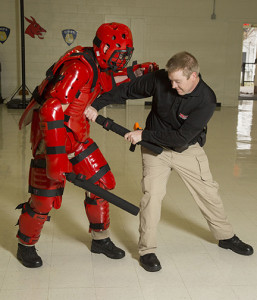By ANDREA LOPEZ
Multimedia Editor
(WARRENSBURG, Mo., digitalBURG) — The university chose red once again, but this time for a suit.

PHOTO SUBMITTED
Recent Central Missouri Police Academy cadets Daniel Henry, left, and Jeremy Head demonstrate the RedMan suit.
The Central Missouri Police Academy added new equipment to their inventory in November 2015 with the addition of defensive tactics-training gear, known as the RedMan suit.
Collin Comer, academy director of the Central Missouri Police Academy, said the purpose of the suit is to train cadets in a more realistic and effective manner.
“When you train with something like a RedMan suit, every student can come out of here with a much better idea of what really is and is not effective for them,” Comer said. “Not every technique works the same for everybody.”
Comer said they’ve wanted the RedMan suit for a while; it was just a matter of budget.
A UCM Foundation Opportunity Grant funded $3,229 to cover costs for the purchase of the RedMan suit and 24 padded batons, according to the UCM Office of Alumni Relations and Development.
With one semester under their belts, instructors like Sonny Lynch continue to use the RedMan suit by simulating various scenarios throughout the academy.
“When we train cadets, we teach them to control a person that doesn’t want to be controlled,” said Lynch, defensive tactics instructor at CMPA and police captain for the Clinton Police Department. “Once they’ve attained a certain level of competence at those techniques, the RedMan suit allows them to pick up their game and add more speed and more dynamic movement to the techniques that they’re doing.”
When Lynch used a RedMan suit for the first time, he said the experience added realism to the training.
“(You’re) able to use full dynamic speed against a human form, instead of a training bag or a dummy or just something that was static and not moving,” he said.
Comparing it to sports, Comer said using the suit is like anything else.
“If you took football, if you took basketball, and you just had them walk through their drills, without ever actually scrimmaging, without actually playing in a practice game, they would never get it down,” he said. “It’s the exact same thing here.”
The only difference seems to be the type of equipment being used.
“The problem is with ours, we use batons and strikes and kicks and whatever things you might have to do to protect yourself or somebody else on the street,” Comer said. “Well, then you got to be padded up pretty well to keep things functioning.”
While the RedMan suit may look complex, it doesn’t take special training to use. At the same time, it does add a layer of protection that seems a bit supernatural.
“It’s real easy to be in the RedMan suit and absorb blows and things like that and not be affected by it,” Lynch said.
“Basically (it’s like being) a terminator – no matter how hard someone hits you, or what they do, you can keep going. We discourage that for the most part; however, we do train with the understanding that there are people on this planet that sometimes that is the case because of sheer willpower or maybe a substance abuse issue, or some meds that they have on board – they do not respond to pain, they do not respond to impact, things like that.”
When it comes to the scenarios-based training, Lynch says they’re looking for officers to display proper judgment in using force against someone.
“We’re looking for them to use the techniques and tactics that they’ve been instructed in,” he said. “And in many cases, we’re looking for them to not use those techniques. We run almost as many scenarios where you don’t use force, as ones where you do.”
Even when it comes to traffic stop training and building clearing, Lynch said the RedMan suit can benefit cadets in various ways.
During the four-month program, cadets usually come into contact with the RedMan suit toward the middle and end of their time at the academy.
“What I’ve enjoyed personally is that I’ve been able to encourage officers to use their training and their techniques that they’ve learned in the classroom at full speed,” Lynch said. “I’ve been able to watch, as a result of that, officers gain confidence. And a confident officer is a professional officer. And a professional officer is a courteous officer and a safe officer.
“Our program is constantly evolving and improving, and the difference between when I started there in 1999 and the type of training and the type of recruits that we graduate today are just like day and night,” Lynch said. “In the last 5 or 6 years, become a very professional and incredibly respected program here in the Midwest.”
The Central Missouri Police Academy is located at 200 Ming St.



Leave a Reply